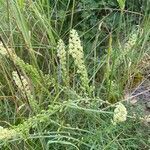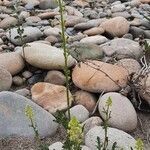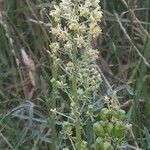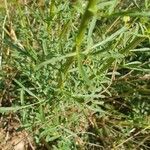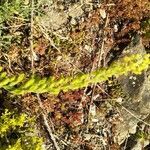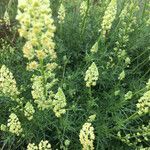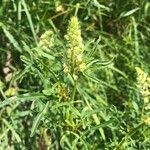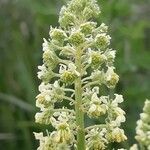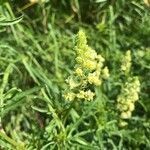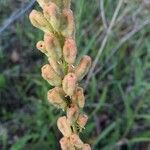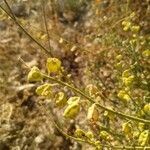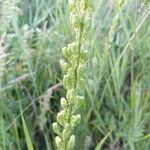Plants annual or perennial, 30-80 cm, glabrous, papillose-scabrid, or hirtellous. Stems erect or ascendent, branched. Leaves: blade obovate, 4-10 × 1-2.5 cm, margins entire or ternately to biternately lobed (lobes 1-3 pairs, narrow-oblong or lanceolate-linear, margins flat or repand), surfaces scabrous or glabrous. Racemes 10-20(-50) cm; bracts caducous, oblong-linear, 2-4 mm. Pedicels 3-7 mm. Flowers (rarely polygamous); sepals persistent or tardily deciduous, (5-)6, not reflexed in fruit, linear-oblong, 3-4 mm; petals (5-)6, yellow, 2-5 mm, rounded-clawed, adaxial ones trisect, lateral lobes semilunate or falcate, margins entire or incised; stamens (12-)14-18; filaments deciduous, 1.5-3 mm, scabrid-papillose; intrastaminal nectary-discs pilose; anthers 0.9-1.5 mm; placenta entire. Capsules usually erect, 3-carpelled, cylindric or ovoid to subglobose, 7-15 × 4-6 mm, apically 3-toothed, glabrous or papillose, ribs scabrid. Seeds 1.4-2 mm, glossy, smooth (carunculate). 2n = 48.
Biennial to perennial glabrous taprooted herb, 30-80 cm tall; rootstock woody; stems and branches erect to ascending, ribbed, hollow, branched. Lvs obovate-cuneate, 2-10 × 1-7 cm; margins tuberculate, flat or undulate. Basal lvs not lobed or pinnatifid with 1-2 pairs of lobes; upper lvs pinnatifid, with 1-(3) pairs of lobes, constricted above lobes; lobes narrow-obovate, becoming linear, rarely again pinnatifid. Pedicels erecto-patent, (3)-5-8 mm long. Sepals usually 6, linear. Petals yellow, usually 6; limbs of posterior pair 3-fid, of lateral pair 2-3-fid, of anterior pair 1-(3)-fid. Stamens 12-20; filaments falling before fr. ripens. Capsule oblong to ellipsoid, usually tuberculate, rarely smooth, (6)-10-18 × (2)-5-8 mm long; carpels 3. Seeds black, smooth, shiny, 1.5-2 mm long.
Perennial herb, sprawling to erect, 20–80 cm high, with basal rosette; glabrous or scabrous-papillose. Leaves often with 1–2 glands near base; basal leaves usually entire, ±petiolate; cauline leaves pinnatifid, with 3–7 mucronate lobes 2–6 cm long and 1–7 mm wide. Raceme up to 40 cm long; bracts narrowly lanceolate, 2–5 mm long, caducous; pedicels mostly 2–6 mm long. Sepals 6, linear, 1.5–4 mm long. Petals 5, deeply 2–3-lobed, the lobes narrowly linear or broadly falcate; claws with obovate ciliate appendages. Disc 1.5–2 mm wide, pilose. Stamens 14–18; anthers 1–1.5 mm long; filaments 2 mm long, falling off after flowering. Ovary densely papillose, with 3 prominent teeth. Capsule 8–13 mm long, 4–6 mm wide, contracted below apex; ribs papillose. Seeds smooth, brown, shiny.
Annual to perennial herb, 0.25-1.80 m high; scabrid-papillose to glabrous. Leaves simple, trifid or pinnatifid; pinnae 2-4 pairs, segments ± linear-lanceolate. Inflorescences spike-like racemes, up to 140 mm long, many-flowered. Flowers bisexual, pedicelled. Sepals 5 or 6. Petals 6, yellow, basal portion with papillose margins, upper portion 3-lobed, lateral lobes finely lunate, centre lobe linear. Disc long papillose. Stamens ± 20. Ovary of 2-5 carpels, 1-locular, open at top, with 2-5 apical, conical points bearing stigmatic surfaces; ovules many, arranged in rows. Fruit leathery, indehiscent capsules, gaping at apex. Seeds many, ± reniform, yellow, smooth.
Herbs annual or perennial, caespitose, 30-75 cm tall, glabrous. Stem branched, angular. Leaves 3-5-parted to pinnatifid, papery; lobes linear, margin repand. Flowers in terminal racemes, yellow to yellowish green; pedicel 3-5 mm. Sepals 6, linear, unequal, shorter than pedicel. Petals 6, rounded-clawed at base, lower 2 entire, lateral two 2-or 3-parted, upper 2 largest, 3-parted. Stamens 12-20. Carpels 3, connate. Capsule erect, cylindric or ovoid to subglobose, obtusely 3-angled, ca. 1 cm, apically 3-cleft. Seeds black, shiny, reniform, ca. 2 mm. Fl. and fr. Jul-Aug. 2n = 12, 24, 48.
A herb. It can grow each year from seed or keep growing from year to year. It is 30-75 cm tall. It spreads 50-70 cm wide. The stem is branched and angular. The leaves have 3-5 parts. They are papery. The lobes are narrow. The flower racemes occur at the end of stalks. They are yellow ot yellowish green. There are 6 petals which are rounded and clawed at the base. The fruit is a capsule which is 3 angled. The seeds are shiny and black. They are kidney shaped and about 2 mm across.
Erect or ascending, diffusely branched, taprooted biennial or perennial to 8 dm, glabrous; lvs irregularly pinnatifid, with a few narrow, entire or cleft lateral segments chiefly near or above the middle; fls greenish-yellow; pet usually 6, with appendages as in no. 1[Reseda alba L.]; filaments deciduous; ovary and fr usually with 3 apical lobes; 2n=48. Waste places, N. Engl. to Io., Mo., and Md.; intr. from Europe.
